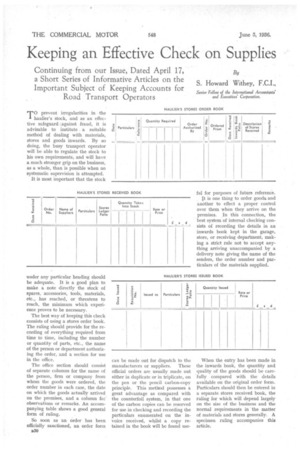Keeping an Effective Check on Supplies
Page 40

Page 41

If you've noticed an error in this article please click here to report it so we can fix it.
Continuing from our Issue, Dated April 17, a Short Series of Informative Articles on the Important Subject of Keeping Accounts for Road Transport Operators
TO prevent irregularities in the haulier's stock, and as an effective safeguard against fraud, it is advisable to institute a suitable method of dealing with materials, stores and goods inwards. By so doing, the busy transport operator will be able to regulate the stock to his own requirements; and will have a much stronger grip on the business, as a whole, than is possible when no systematic supervision is attempted.
It is most important that the stock under any particular heading should be adequate. It is a good plan to make a note directly the stock of spares, accessories, tools, materials, etc., has reached, or threatens to reach, the minimum which experience proves to be necessary.
The best way of keeping this check consists of using a stores order book. The ruling should provide for the recording of everything required from time to time, including the number or quantity of parts, etc., the name of the person or department authorizing the order, and a section for use in the office.
The office section should consist of separate columns for the name of the person, firm or company from whom the goods were ordered, the order number in each case, the date on which the goods actually arrived on the premises, and a column for observations or remarks. An accompanying table shows a good general form of ruling.
So soon as an order has been officially sanctioned, an order form B30 can be made out for dispatch to the manufacturers or suppliers. These official orders are usually made out either in duplicate or in triplicate, on the pen or the pencil carbon-copy principle. This method possesses a great advantage as compared with the counterfoil system, in that one of the carbon copies can be reserved for use in checking and recording the particulars enumerated on the invoice received, whilst a copy retained in the book will be found use ful for purposes of future reference.
It is one thing to order goods. and another to effect a proper control over them when they arrive on the premises. In this connection, the best system of internal checking consists of recording the details in an inwards book kept in the garage, store, or receiving department, making a strict rule not to accept anything arriving unaccompanied by a delivery note giving the name of the senders, the order number and particulars of the materials supplied.
When the entry has been made in the inwards book, the quantity and quality of the goods should be care'fully compared with the details available on the original order form. Particulars should then be entered in a separate stores received• book, the ruling for which will depend largely on the size of the business and the normal requirements in the matter of materials and stores generally. A specimen ruling accompanies this article. Upon receipt of the invoke, the price and the discount should be checked, after which the form can be signed or initialled and passed for payment. It is a good practice to stamp all invoices with a rubber or other suitable impression, so soon as they come to hand. This stamp could be in the following form :—
INVOICE STAMP.
Materials received by Number or quantity verified by Prices and discounts checked by Extensions and additions tested by Approved by Passed toe payment by Inwards book folio Purchases book folio
All issues made from stock should be supported by properly signed requisitions, and the details recorded in a stores issued book (see accompanying table).
Stores Procedure.
The stores issued book could also be provided with a number of classification columns to enable all goods issued to be systematically extended under their most appropriate headings. Where this is done, the various columns should be aaded up each day, a good check on the accuracy of the figures being afforded by seeing that the, cross additions correspond with the " amount " column. The delivery forms used by the transport operator should be made out on the counterfoil principle, the larger portion detailing the goods issued and the small part signed by the receiver.
The stock on hand under any heading can be readily ascertained by keeping separate accounts in a
stores ledger. Each account will have its debit and its credit sides, the former being entered up from the particulars recorded in the stores received book, and the latter from the stores issued book. When small quantities are issued from the bulk, it is advisable to add to the issued records a small percentage, say 21-, to cover leakages, etc.
A Rejection Book.
In a large business, where the number of rejections during the working year is considerable, a stores rejection book could be kept. Provision should be made in it for inserting the date of each rejection, the original order number, the name of the Manufacturers or suppliers, details of the goods returned (including the number, weight, quantity, etc.), the cause or causes of rejection, and the date of the credit note.
Goods arriving on the operator's premises from boat or train should be marked to show that the,cases have not been examined.




















































































